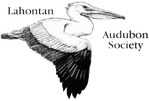|
By Kath Giel In February 2022, LAS sponsored two birding trips to Costa Rica. Participating in the trips were 20 enthusiastic birders, from beginner to experienced, including former and current Board members Suzie Reynolds, Valerie Andersen, Kathy Oakes, and LAS employee Parker Flickinger. The two trips had the same itinerary but of course the birds seen and the weather experienced varied. There were many highlights on each trip. The trip started at the Bougainvillea Hotel in San Jose, Costa Rica’s capital city in the Central Valley. In the ten acre garden at the hotel property, we all became familiar with some of the birds that would be seen regularly throughout the trip such as the Great Kiskadee, Tropical Kingbird, Hoffman’s Woodpecker, Rufous-Naped Wren, and the Rufous-Tailed Hummingbird. Our first destination was Carara National Park near the Pacific Coast. We hiked the trails of the park, learning about the primary and secondary successional forests and seeing birds of the area including the brilliant Scarlet Macaw. The Scarlet Macaw, once threatened mostly due to the exotic bird trade, is now thriving in the area due to strict laws that protect them and their habitat. Near Carara Park we also took a boat tour on the Tarcoles River, traveling mangrove, estuarine, cultivated landscapes, coastal habitat, from the crocodile-infested river shores to the open sea and then back into the depths of the mangroves. We saw 4 species of kingfishers, the Mangrove Warbler, many Brown Pelicans, Magnificent Frigatebirds, and Royal Terns. We also made several side trips, and were lucky to see a Ferruginous Pygmy Owl during the day. Our journey then took us next to Monteverde, a primary and secondary cloud forest at an altitude of nearly 5,000 feet. We welcomed the cool weather and spectacular sunsets from this area. During our time here we visited a farm in the San Luis valley where we were delighted with sightings of a female Ornate Hawk-Eagle on her nest. While here we also saw White Hawks, Broad-Winged Hawks, Black Hawks, and some Golden-Olive Woodpeckers on the feeder. Enroute we also were thrilled to see and hear the Three Wattled Bellbird. While each group went to a different reserve in Monteverde, both groups saw Resplendent Quetzals, male and female. It was a thrill to see them fly in the forest, their brilliant colors flashing in the sun and shade. We were also excited to see Lesson’s Motmot and a Collared Trogon. Our next destination was the Arenal volcano area, which is considered the Caribbean foothill rainforest. We stayed at the famous Arenal Observatory Lodge, which was built to accommodate scientists and students from the Smithsonian who originally came to observe and study the erupting Arenal volcano. The view of the bird feeders from the deck of the Observatory dining area was a treat in itself; amongst the species we saw were Emerald Tanagers, Golden Crowned Tanagers, Blue Gray Tanagers, Scarlet Rumped Tanagers, Euphonias, Red Legged Honeycreepers, Green Honeycreepers, Red-Naped Woodpecker, and Aracari. Not to be outdone, the larger birds that followed included the Montezuma Oropendola and the Great Curassow. We took a very long day trip to the unique wetlands near the Nicaraguan border at Caño Negro. Traveling by boat, Amazon Kingfishers, Green Kingfishers, Anhingas, Roseate Spoonbills, Jacanas, Boat-billed Herons, Wood Storks, Black Necked Stilts, and Neotropic Cormorants were abundant. Enroute we also saw Nicaraguan Seed Finches and a Great Potoo nesting on a tree branch, looking like it was just a stump. We returned to the Central Valley, stopping for lunch at an area with hummingbird and fruit feeders and enjoyed seeing the Emerald Tanagers, Violet-Headed Hummingbirds, and the ubiquitous Rufous-Tailed Hummingbird. As part of the trip, each person donated $200 to three conservation organizations: the Cabanisi Project working to protect and support the endemic and endangered Cabanisi’s Ground-Sparrow; the Costa Rica Conservation Foundation leading reforestation efforts of tropical forests in Monteverde; and Ecocentro Danaus where conservation, training, environmental education and sustainable production programs are developed After a presentation of the endangered Cabanisi Ground Sparrow, we went to a mature coffee plantation in San Jose where these birds are known to inhabit and were delighted to see them. As part of the Monteverde project, we had a presentation on the magical Three-Wattled Bellbird, and the following day we participated in a bird banding project which the groups found to be very informative. We finally visited the Danaus Ecocenter to hear about their activities with education and conservation and observed some sloths while visiting their preserve. Everyone was very happy to have contributed to these inspirational organizations. In the end, the trips were huge successes. Each group recorded in excess of 300 species of birds in 11 days! Here is the ebird field trip report for our 2nd trip, where you can see all the species we saw: https://ebird.org/tripreport/38549. Our guide, Mario Cordoba, and driver, Rodrigo, were so helpful in finding and pointing out birds and giving us tips and background about the birds to enhance our knowledge. All in all it was a great trip with wonderful camaraderie. As they say in Costa Rica “¡Pura vida!.” |
topics
All
Archives
July 2024
|


 RSS Feed
RSS Feed